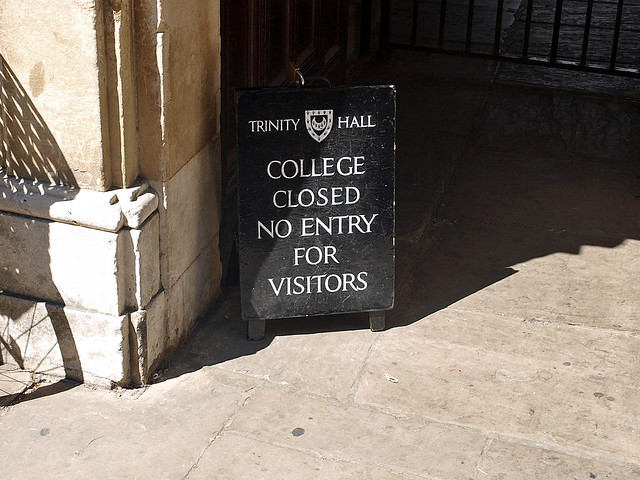The CHAPEL was licensed as early as 1352 and is thus the earliest chapel projected specially for a College. But it was consecrated only in 1513. However, a Piscina remains which may well be of the late C14. The Chapel is reached by the usual small antechapel. Here are a C14 doorway towards the former Master’s Lodge, some carved STONE FRAGMENTS of the demolished church of St John Zachary and several BRASSES: to T. Preston d. 1510 with effigy; to a priest (small; no name). The chapel itself was modernized in 1729-30. It has a shallow curved white ceiling and simple organ gallery and reredos. (Tactful E enlargement by Salvin 1864). ALTAR PAINTING by Stella (Presentation in the Temple), bought in Flanders. - RELIEF on the N wall: Ascension by James Forsyth, London. - MONUMENT to Robert King d. 1676, a large black marble slab in the floor with incised coat of arms and fine lettering, very typical of its date. - J. Andrew d. 1747, with relief portrait in medallion and rocaille cartouche; excellent.
By the side of Clare’s magnificence, Trinity Hall seems a humble neighbour, content with a coat-of-arms over an entrance plain to insignificance, opening to one of two small courts by Trinity Hall Lane. On many a milestone on the highways about Cambridge is set the crescent of the shield of its founder, William Bateman. He founded Trinity Hall in 1350 for the study of law, and the buildings rose about a hostel for student-monks from Ely, which eventually became a pigeon-house. The old buildings have been much transformed, but on the south side of the second court medieval windows are still to be seen, one a tiny quatrefoil.
The hall has 18th century woodwork, and portraits of Lord Justice Romer, John Oxenden, Sir Alexander Cockburn (Lord Chief Justice, painted by Watts), Sir John Eardley Wilmot, Sir Nathaniel Lloyd, and Edward Anthony Beck. Among other members of Trinity Hall were Bulwer Lytton, Lord Howard of Effingham, the famous Earl of Chesterfield, and the infamous Bishop Gardiner.
The bright little chapel has traces of medieval work, an 18th century plaster ceiling enriched with shields and huge flowers, a Jacobean altar table, and a huge altarpiece of Simeon with Jesus. The rows of wrought-steel candlesticks on the seats have William Bateman’s crescent. There is a brass portrait of Thomas Preston of 1598, dramatist and Master of the college; his hands are at prayer, but part of his head is gone.
Beyond the hall range is a third court, with the lawns and fine trees of the Fellows’ Garden. Facing each other on two sides are the Master’s Lodge and the library, and curving towards the river are the fine new buildings put up by the growing college. Built into the new is the medieval gateway, taking us now to one of the lovely bridges crossing to the Backs.
The Master’s Lodge, with a big gable, is almost new; but the library, a charming little place with creepered brick walls and stepped gables, is almost all Elizabethan. The stone-framed windows have been refaced, and flowering plants and shrubs climb up to reach them. In the long narrow room on the first floor the bookcases stand at right-angles to the walls, with shelves at the top for the readers who stand and book-rests for those who sit.
The hall has 18th century woodwork, and portraits of Lord Justice Romer, John Oxenden, Sir Alexander Cockburn (Lord Chief Justice, painted by Watts), Sir John Eardley Wilmot, Sir Nathaniel Lloyd, and Edward Anthony Beck. Among other members of Trinity Hall were Bulwer Lytton, Lord Howard of Effingham, the famous Earl of Chesterfield, and the infamous Bishop Gardiner.
The bright little chapel has traces of medieval work, an 18th century plaster ceiling enriched with shields and huge flowers, a Jacobean altar table, and a huge altarpiece of Simeon with Jesus. The rows of wrought-steel candlesticks on the seats have William Bateman’s crescent. There is a brass portrait of Thomas Preston of 1598, dramatist and Master of the college; his hands are at prayer, but part of his head is gone.
Beyond the hall range is a third court, with the lawns and fine trees of the Fellows’ Garden. Facing each other on two sides are the Master’s Lodge and the library, and curving towards the river are the fine new buildings put up by the growing college. Built into the new is the medieval gateway, taking us now to one of the lovely bridges crossing to the Backs.
The Master’s Lodge, with a big gable, is almost new; but the library, a charming little place with creepered brick walls and stepped gables, is almost all Elizabethan. The stone-framed windows have been refaced, and flowering plants and shrubs climb up to reach them. In the long narrow room on the first floor the bookcases stand at right-angles to the walls, with shelves at the top for the readers who stand and book-rests for those who sit.

No comments:
Post a Comment